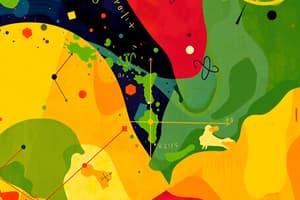Podcast
Questions and Answers
Statistics and game theory emerged as mathematical disciplines primarily from the field of theoretical mathematics.
Statistics and game theory emerged as mathematical disciplines primarily from the field of theoretical mathematics.
False (B)
Mathematical proofs are used by mathematicians to determine the validity of established laws of nature.
Mathematical proofs are used by mathematicians to determine the validity of established laws of nature.
False (B)
The primary motivation for pure mathematics is its immediate practical applicability to real-world problems.
The primary motivation for pure mathematics is its immediate practical applicability to real-world problems.
False (B)
All mathematicians agree on a single, universally accepted definition of what exactly constitutes mathematics.
All mathematicians agree on a single, universally accepted definition of what exactly constitutes mathematics.
The base-60 numeral system, foundational to aspects of time measurement, originated in ancient Egyptian mathematics.
The base-60 numeral system, foundational to aspects of time measurement, originated in ancient Egyptian mathematics.
The oldest evidence of mathematical activity dates back approximately 3,000 years to ancient Greece.
The oldest evidence of mathematical activity dates back approximately 3,000 years to ancient Greece.
Quadratic and cubic equations were explored in the Old Babylonian period.
Quadratic and cubic equations were explored in the Old Babylonian period.
Ancient Egyptians and Mesopotamians worked collaboratively to develop a unified system of mathematics.
Ancient Egyptians and Mesopotamians worked collaboratively to develop a unified system of mathematics.
The Rhind Mathematical Papyrus, dating back to approximately 1650 BC, primarily focuses on problems related to astronomy and physics.
The Rhind Mathematical Papyrus, dating back to approximately 1650 BC, primarily focuses on problems related to astronomy and physics.
Euclid's Elements primarily used inductive reasoning to demonstrate geometric theorems.
Euclid's Elements primarily used inductive reasoning to demonstrate geometric theorems.
Archimedes accurately calculated the precise value of pi ($\pi$) to an infinite number of decimal places.
Archimedes accurately calculated the precise value of pi ($\pi$) to an infinite number of decimal places.
Al-Khwarizmi's The Compendious Book on Calculation by Completion and Balancing focused exclusively on solving differential equations.
Al-Khwarizmi's The Compendious Book on Calculation by Completion and Balancing focused exclusively on solving differential equations.
Leonardo Fibonacci is credited with independently discovering the Hindu-Arabic numeral system in the 12th century.
Leonardo Fibonacci is credited with independently discovering the Hindu-Arabic numeral system in the 12th century.
Nicolaus Copernicus primarily used advanced statistical methods to develop his heliocentric model of the solar system.
Nicolaus Copernicus primarily used advanced statistical methods to develop his heliocentric model of the solar system.
René Descartes' development of analytic geometry bridged algebra and calculus.
René Descartes' development of analytic geometry bridged algebra and calculus.
Non-Euclidean geometry, developed in the 19th century, confirmed the uniqueness of Euclidean geometry as the only valid geometric system.
Non-Euclidean geometry, developed in the 19th century, confirmed the uniqueness of Euclidean geometry as the only valid geometric system.
Kurt Gödel's completeness theorems demonstrated that all true statements in mathematics can be proven within the system.
Kurt Gödel's completeness theorems demonstrated that all true statements in mathematics can be proven within the system.
Axioms are proven statements used to define new mathematical terms.
Axioms are proven statements used to define new mathematical terms.
Pure mathematics focuses on solving practical problems, while applied mathematics explores abstract concepts.
Pure mathematics focuses on solving practical problems, while applied mathematics explores abstract concepts.
Applied mathematics has not directly resulted in the discovery of new areas and concepts within pure mathematics.
Applied mathematics has not directly resulted in the discovery of new areas and concepts within pure mathematics.
The development of the number system concluded with the introduction of rational numbers and no further extensions occurred.
The development of the number system concluded with the introduction of rational numbers and no further extensions occurred.
Number theory primarily focuses on the study of real numbers, including their continuous properties and calculus-based applications.
Number theory primarily focuses on the study of real numbers, including their continuous properties and calculus-based applications.
Trigonometry explores the fundamental properties of abstract algebraic structures, such as groups, rings, and fields.
Trigonometry explores the fundamental properties of abstract algebraic structures, such as groups, rings, and fields.
Flashcards
Mathematics
Mathematics
Study of quantity, structure, space, and change.
Mathematical Conjectures
Mathematical Conjectures
Identifying patterns and creating new educated guesses.
Mathematical Proofs
Mathematical Proofs
Verifying conjectures through rigorous logical steps.
Mathematical Reasoning
Mathematical Reasoning
Signup and view all the flashcards
History of Mathematics
History of Mathematics
Signup and view all the flashcards
Early Uses of Math
Early Uses of Math
Signup and view all the flashcards
Mesopotamian Mathematics
Mesopotamian Mathematics
Signup and view all the flashcards
Base-60 System
Base-60 System
Signup and view all the flashcards
Rhind Mathematical Papyrus
Rhind Mathematical Papyrus
Signup and view all the flashcards
Euclid
Euclid
Signup and view all the flashcards
Al-Khwarizmi
Al-Khwarizmi
Signup and view all the flashcards
Leonardo Fibonacci
Leonardo Fibonacci
Signup and view all the flashcards
René Descartes
René Descartes
Signup and view all the flashcards
Newton & Leibniz
Newton & Leibniz
Signup and view all the flashcards
Axioms
Axioms
Signup and view all the flashcards
Theorems
Theorems
Signup and view all the flashcards
Pure Mathematics
Pure Mathematics
Signup and view all the flashcards
Applied Mathematics
Applied Mathematics
Signup and view all the flashcards
Numbers
Numbers
Signup and view all the flashcards
Number Theory
Number Theory
Signup and view all the flashcards
Abstract Algebra
Abstract Algebra
Signup and view all the flashcards
Analysis
Analysis
Signup and view all the flashcards
Geometry
Geometry
Signup and view all the flashcards
Study Notes
- Mathematics studies quantity, structure, space, and change.
- Mathematicians and philosophers hold a range of views on the exact scope and definition of mathematics.
- Mathematics seeks patterns and creates new conjectures.
- Truth or falsity of conjectures are resolved by mathematical proofs.
- Mathematical reasoning offers insight/predictions about nature when mathematical structures model real phenomena well.
- Mathematics evolved through abstraction and logical reasoning from counting, calculation, measurement, and the systematic study of physical objects' shapes/motions.
- Practical mathematics has been a human activity throughout recorded history.
- Mathematical research is ongoing.
- Mathematics is essential in natural science, engineering, medicine, finance, and social science.
- Applied mathematics has spurred new mathematical disciplines like statistics and game theory.
- Pure mathematics is pursued for its own sake, without consideration of application.
- Mathematicians do not have a consensus on what constitutes mathematics.
- Schools of thought are united by logical rigor, abstraction, and generality.
- Mathematics is broadly classified into algebra, analysis, and geometry.
- Subdivisions investigate links from mathematics to logic, set theory (foundational mathematics), empirical sciences (applied mathematics), and uncertainty.
History
- Mathematics history is intertwined with social developments.
- Tally marks dating back 30,000 years suggest early human mathematics use.
- Early mathematics served trade, land surveying, taxation, and calendar development.
Ancient Near East (c. 3000–300 BC)
- Mesopotamian mathematics originated in Sumer from 3000 BC.
- A base-60 numeral system was developed.
- Old Babylonian period (c. 2000–1600 BC) tablets cover fractions, algebra, quadratic/cubic equations, and regular reciprocal pair calculations.
- Babylonian tablets hold the oldest known √2 approximation.
- Egyptian mathematics developed independently from Mesopotamia, starting in the predynastic period (c. 3000 BC).
- The Rhind Mathematical Papyrus (c. 1650 BC) is a key source, featuring arithmetic, algebra, geometry, and trigonometry problems.
- The Moscow Mathematical Papyrus is another important source.
- It contains geometry problems, such as finding the volume of a frustum.
Classical Antiquity (c. 800 BC – 600 AD)
- Greek mathematics began with Thales (c. 624–546 BC) and Pythagoras (c. 582–507 BC).
- Pythagoras believed "All is number" and sought to explain the world through numbers.
- Euclid (c. 300 BC) systematized mathematical knowledge in Elements.
- Elements used deductive reasoning to present geometric theorems with proofs.
- Archimedes (c. 287–212 BC) devised methods for calculating areas and volumes.
- He also approximated pi (π).
- Diophantus (c. 200–284 AD) is considered the "father of algebra".
- Greek mathematics played a role in astronomy and geography.
Middle Ages (c. 500–1500 AD)
- Mathematics thrived in the Islamic world during the Middle Ages, especially in the 9th and 10th centuries.
- Muslim mathematicians advanced Greek mathematics and created new concepts.
- Al-Khwarizmi (c. 780–850 AD) is considered the "father of algebra".
- He introduced systematic approaches to solve linear/quadratic equations in The Compendious Book on Calculation by Completion and Balancing.
- Arabic numerals, including zero, originated in India and spread to the Islamic world and Europe.
- Leonardo Fibonacci (c. 1170–1250 AD) popularized the Hindu-Arabic numeral system in Europe via Liber Abaci.
- Medieval scholars translated Greek/Arabic texts into Latin, disseminating mathematical knowledge in Europe.
- Indian mathematics contributed significantly to trigonometry, including sine and cosine functions.
Renaissance and Early Modern Period (c. 1400–1700 AD)
- European mathematicians made discoveries and developed tools during the Renaissance.
- 16th-century Italy saw solutions for cubic and quartic equations.
- Nicolaus Copernicus (1473–1543) used mathematics for his heliocentric solar system model.
- Johannes Kepler (1571–1630) used math to develop his laws of planetary motion.
- René Descartes (1596–1650) created analytic geometry, combining algebra and geometry.
- Isaac Newton (1643–1727) and Gottfried Wilhelm Leibniz (1646–1716) independently invented calculus.
- Calculus enabled new solutions for physics, engineering, and other fields.
Modern Period (c. 1700–present)
- The 18th and 19th centuries saw rapid mathematical development.
- Leonhard Euler (1707–1783) contributed to calculus, number theory, and graph theory.
- Joseph-Louis Lagrange (1736–1813) developed Lagrangian mechanics, used in physics/engineering.
- Carl Friedrich Gauss (1777–1855) advanced number theory, algebra, and analysis.
- Non-Euclidean geometry emerged in the 19th century.
- This challenged Euclidean geometry as the only possible geometry.
- Georg Cantor (1845–1918) developed set theory, a foundation of modern mathematics.
- The 20th century saw mathematics become more abstract and specialized.
- David Hilbert (1862–1943) proposed 23 unsolved problems that have guided mathematical research.
- Kurt Gödel (1906–1978) proved incompleteness theorems, demonstrating limits to provability in mathematics.
- Computers have revolutionized mathematics, enabling solution of complex problems and exploration of new ideas.
- Mathematics is applied across science, engineering, finance, and computer science.
Notation, terminology, and style
- Mathematics relies on notation.
- Mathematical notation has evolved over centuries.
- Mathematical notation makes mathematics efficient.
- Mathematical notation employs specific terminology.
- Mathematics typically uses a hierarchy of axioms, definitions, and theorems.
- Axioms are self-evident statements.
- Definitions define new terms using existing ones.
- Theorems are proven true using axioms, definitions, and previously proven theorems.
- Proofs are used to demonstrate the truth of theorems.
Pure and applied mathematics
- Pure mathematics explores mathematical concepts without regard to external applications.
- Applied mathematics uses mathematical concepts to address problems in other fields.
- Pure mathematics can later find applications.
- Applied mathematics can influence pure mathematics.
- Applied mathematics can lead to discovery and exploration of new mathematical areas.
Branches of mathematics
- Mathematics has a large number of different areas
- These areas can be divided in different ways
Quantity
- Quantity begins with numbers
- Numbers are familiar as the counting numbers
- The number system has been extended over the centuries to include fractions, rational numbers, irrational numbers, and complex numbers.
- Number theory studies the properties of integers.
- Number theory contains unsolved problems.
Structure
- Many mathematical objects, such as sets of numbers and functions, exhibit internal structure as a consequence of the operations or relations that are defined on the set.
- Mathematics then studies properties of these structures.
- Abstract algebra studies algebraic structures such as groups, rings, and fields.
- Analysis studies structures that involve the concept of limit, such as real numbers, complex numbers, and functions.
Space
- Space is studied through geometry.
- Trigonometry studies the relationships between the sides and angles of triangles.
- Differential geometry studies curves and surfaces.
- Topology studies properties of space that are preserved under continuous deformations.
Change
- Understanding and describing change is a common theme in the natural sciences.
- Calculus was developed to investigate change.
- Vector calculus extends calculus to functions of several variables.
- Differential equations study functions that describe how quantities change over time.
- Dynamical systems theory studies systems that evolve over time.
- Chaos theory studies systems that are highly sensitive to initial conditions.
Studying That Suits You
Use AI to generate personalized quizzes and flashcards to suit your learning preferences.




